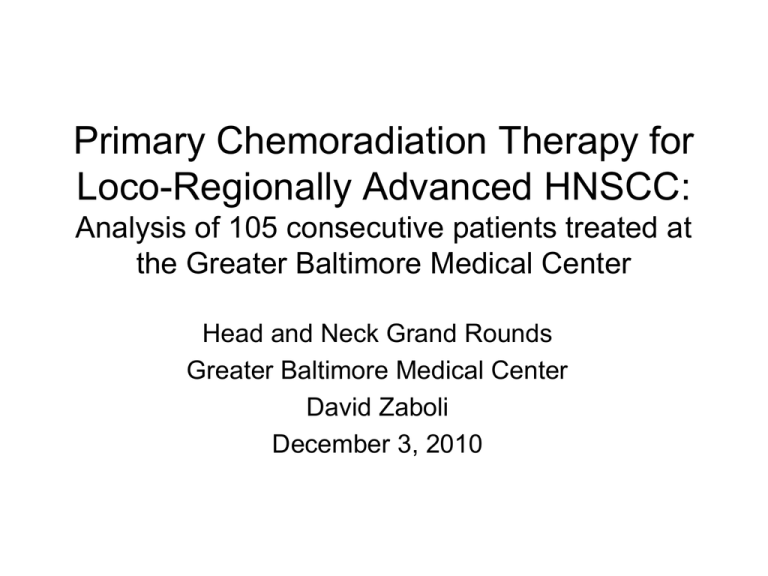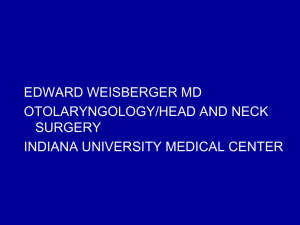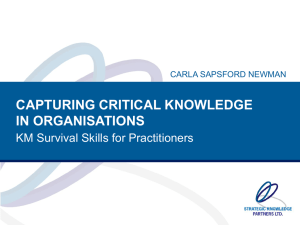
Primary Chemoradiation Therapy for
Loco-Regionally Advanced HNSCC:
Analysis of 105 consecutive patients treated at
the Greater Baltimore Medical Center
Head and Neck Grand Rounds
Greater Baltimore Medical Center
David Zaboli
December 3, 2010
Disclosures
None
Overview
• Epidemiology
• Risk Factors
• Review of evidence for chemoradiation therapy
for primary treatment of HNSCC
• Results of 105 patients treated with Brizel
Regimen at GBMC
• Future Projects
Epidemiology
• 620,000 cases of Head and
Neck Cancer worldwide in
2009
• 6th most common cancer
• 6% of all malignancies
worldwide
• 1,529,560 cases of cancer
in the USA
• 48,000 cases of HNC in
USA in 2009
• 11,300 deaths from HNC
Incidence of HNC varies greatly by
region
• Highest incidence/death
rates Rural Georgia
12.5/2.9
• Lowest incidence Utah
8.06/1.7
• Top 5 states overall
deaths DC, MS, LA, SC,
TN
• Bottom 5 states MT, NE,
CT, NM, UT
5-year Survival
Oral Cavity and Oropharynx
• 1975-1977
53.1
• 1978-1980
54.0
• 1981-1983
52.6
• 1984-1986
54.6
• 1987-1989
54.2
• 1990-1992
56.2
• 1993-1995
58.4
• 1996-1998
58.8
• 1999-2005
62.5
•
•
•
•
•
•
•
•
•
Larynx
1975-1977
1978-1980
1981-1983
1984-1986
1987-1989
1990-1992
1993-1995
1996-1998
1999-2005
Source: SEER Cancer Statistics Review 1975-2006
66.6
66.0
68.8
65.7
66.4
66.6
63.9
65.1
63.2
Racial Discrepancy in Survival
Overall
White
Black
Oral Cavity/
Oropharynx
62.5
61.5 M
64.7 F
64.4
64.1 M
65.0 F
46.1
41.0 M
57.0 F
Larynx
63.2
63.9 M
60.6 F
65.5
66.1 M
62.9 F
50.1
51.3 M
46.5 F
Source: SEER Cancer Statistics Review 1975-2006
• Epidemiology
• Risk Factors
• Review of evidence for chemoradiation therapy
for primary treatment of HNSCC
• Results of 105 patients treated with Brizel
Regimen at GBMC
• Future Projects
Risk Factors
• Tobacco
• Alcohol
•
•
•
•
•
Viral Infection (HPV, EBV)
Occupational exposures
Betel nut chewing
Nutritional deficiency
Immunodeficiency
•
•
•
•
Previous radiation
Poor oral hygiene
Mechanical irritation
Mouthwash that contains
alcohol???
• Previous HNC
• Genetics
• Epidemiology
• Risk Factors
• Review of evidence for chemoradiotherapy for
primary treatment of advanced HNSCC
• Results of 105 consecutive patients treated at
GBMC with the “Brizel” Regimen
• Future Projects
RATIONALE Combination Chemotherapy and
Radiotherapy (CRT) as primary treatment for
HNSCC
• Improved efficacy
• Less morbidity
• Organ preservation
AND often function
• Only option for patients
with unresectable
disease
Toxicity Associated with CRT
Acute
-Mucositis
-Pain
-Swallow
-Chemotherapy
specific
Long-Term
-Swallowing
dysfunction
-Speech
-Soft-tissue
complications
-Vascular
complications
-Xerostomia, change
in sputum
-Cosmetic deformities
-Change/Loss taste
-Hypothyroid
-Esophageal fibrosis
-Psychological
Cisplatin
Mechanism
Side Effects
-DNA intercalation> DNA
damage> apoptosis
-alkylating agent
-peripheral neuropathy
-ototoxicity
-nephrotoxicity
-electrolytes
-myelosuppression
5-Fluorouracil
Side Effects
Mechanism
-noncompetitive inhibition
of thymidylate synthase
-antimetabolite
5-FU
-mucositis
-myelosuppression
-dermatitis
-diarrhea
-cardiac toxicity
Thymine
Mechanism
• Radioresistance of
cancer cells a major
problem
• Chemotherapy combined
with RT to enhance
radiosensitivity by
– Decreasing tumor vol
– Inhibit DNA repair
– Inhibit tumor
repopulation
– Selective kill hypoxic
cells
“Also provides some
adjuvant treatment for
potential distant
metastatic disease”
Brizel J. Clin Oncology 2006
• Insert picture of article
MACH-NC Findings
• CRT improved survival versus surgery alone, surgery +
RT
• Addition of chemotherapy produced absolute survival
benefit of 4.5% at 5 years
• If concomitant CRT, absolute survival 6.5% at 5 years
• In mono-chemotherapy, platin better than non-platins
• Concomitant more effective for LRC
• Induction more effective for distant metastasis
• Benefit of CRT decreases with age
•
•
•
•
Epidemiology
Risk Factors
Case Presentation
Review of evidence for chemoradiotherapy for
primary treatment of advanced HNSCC
• Results of 105 consecutive patients treated at
GBMC with the “Brizel” Regimen
• Future Projects
Study Objectives
Primary Endpoints
Overall Survival (OS)
Date of Death- Date Completion of CRT
Loco-Regional Control (LRC)
Date of Local OR Regional Recurrence – Date
Completion of CRT
Disease-Free Survival (DFS)
Date of Local OR Regional OR Distant
Recurrence – Date Completion of CRT
Study Objectives
Primary Endpoints
Overall Survival (OS)
Date of Death- Date Completion
of CRT
Secondary Endpoints
– Short-term Toxicity
Mucositis, nephrotoxicity,
Neutropenia,
– Long-term Toxicity
Loco-Regional Control (LRC)
Date of Local OR Regional
Recurrence – Date
Completion of CRT
Disease-Free Survival (DFS)
Date of Local OR Regional OR
Distant Recurrence – Date
Completion of CRT
Peg Usage, ORN, Peripheral
Neuropathy, Ototoxicity
– Unplanned Hospitalizations
– Causes of death
Cancer of Head and Neck
Second Primary
Co-Morbidity
Treatment-Related
Unknown
– Second Primary Malignancies
Methods
• Retrospective Review
• Locally Advanced Head and
Neck Squamous Cell
Carcinoma (Stage III-IVb)
• All patients treated at
GBMC between 2000-2007
• N=105
• Medical records reviewed in
Milton Dance Center,
Radiation Oncology, and
Medical Oncology
• Exclusion from review
– Cancer of sinus, salivary
glands
– Unknown primary
– Recurrent cancer
– Previous therapeutic
radiation to Head or
Neck
– Previous systemic
chemotherapy
Treatment Regimen
Chemotherapy
– Cisplatin (12 mg/m2/h)
– 5-Fluorouracil (600
mg/m2/20h)
– Given as inpatient for five
days concomitant with first
and last weeks of radiation
– CBC, BMP pre-treatment,
post week 1, post week 5,
post 4 weeks
Radiation Therapy
– Hyperfractionated 1.25 Gy
BID x 28-30 days
– Primary total dose 70-75
Gy
– Involved Cervical LN 60 Gy
– Uninvolved Cervical and
Supraclavicular LN 50 Gy
– Interruptions minimized
– Treatment break one week
after 40Gy
Prophylactic PEG
Regimen- Continued
6-12 weeks later…
– Visit with provider and
exam of primary tumor site
and neck
– PET/CT
Neck Dissection
– Offered to all patients with
Nodal disease of N2 or
greater
– All but one eligible patient
received
– Type of neck dissection
made on individual basis
Follow-Up
Years 1-2
– Every 2 months
Years 3-5
– Every 3-6 months
Years 5+
– Every 6-12 months
Assessment of Treatment Response
Clinical Response:
Physical Exam and Imaging
Complete
Primary
Neck
Total disappearance
PE < 1 cm or PET FDG consistent
with inflammatory change
Partial
Primary
Neck
Pathologic Response
Complete
Incomplete
Primary
Neck
Partial shrinkage 30-50% longest
dimension
Palpable LAN or FDG activity suggestive of
viable metastatic LN
Biopsy of Primary Tumor or
Pathology of LN
Biopsy reveals viable cancer
LN reveal viable cancer
Patient Characteristics
N=105
Mean age (y)
Range
<55
≥55
Sex
-Female
-Male
Race
-Caucasian
-African American
Site *
-Oropharynx
-Hypopharynx
-Larynx
58.7
43-79
40
65
21
84
90
15
78
15
13
AJCC Stage
-III
-IV
Tumor (T)
-T1
-T2
-T3
-T4
Nodal (N)
-N0
-N1
-N2
-N3
30
75
6
36
45
18
14
24
56
11
Patient Characteristics continued
HPV Status (Oropharynx only)
Smoking
–
–
–
–
–
–
–
No
Yes
<20 PY
20-40 PY
40-60 PY
>60 PY
Unknown
23
82
21
21
18
18
4
No
Unknown
Yes
Social
Moderate
Heavy
25
20
32
Pre-treatment Hemoglobin
– <12
– >12
– Unavailable 8
26
71
KPS
Alcohol
–
–
–
–
–
–
– Positive
– Negative
– Unknown
8
7
90
21
21
18
–
–
–
–
–
<70
80
90
100
Unknown
9
29
31
27
9
Self-reported Weight Loss (lbs)
– None/less than 10
– >10
– Unknown
28
67
10
Response
• Complete clinical response 88%
• Partial clinical response 12%
Overall Survival
Median F/U surviving
patients = 56 months (3-119)
3-year OS
– Stage III
– Stage IV
75%
77%
72%
5-year OS
– Stage III
– Stage IV
60%
63%
58%
Causes of death (N=38)
Number
Head and neck cancer
21
Co-morbidity
3
Second primary malignancy
7
Treatment-related
2
Unknown
5
Factors associated with Overall Survival
Univariate Analysis
Variable
HR
95% CI
pvalue
Age > 55
2.31 1.12-4.75
0.02
Male
0.39 0.19-0.78
0.01
Hgb < 12
0.96 0.43-2.15
0.92
Weight Loss
1.45 0.74-2.83
0.28
KPS ≤70
0.81 0.19-3.39
0.77
Larynx
1.95 0.83-4.55
0.12
Hypopharynx
2.96 1.36-6.45
0.01
T3/T4
Mod-Heavy
drinker
2.34 1.11-4.95
0.03
1.92 0.98-3.75
0.06
Ever Smoker
3.63 1.12-11.80
0.03
>40 PY
2.82 1.05-7.54
0.04
HPV
0.65 0.24-1.73
0.39
Decreased survival
–
–
–
–
–
Age
Hypopharynx
T3/T4
Ever Smoker
> 40 PY
Increased survival
– Male
Factors associated with Survival
Uni and Multivariate Analysis
Multivariate
Univariate
Variable
HR
95% CI
pvalue
HR
95% CI
pvalue
Age > 55
Male
Hgb < 12
Weight Loss
KPS ≤70
2.31
0.39
0.96
1.45
0.81
1.12-4.75
0.19-0.78
0.43-2.15
0.74-2.83
0.19-3.39
0.02
0.01
0.92
0.28
0.77
2.47 1.19-5.13
0.02
Larynx
1.95 0.83-4.55
0.12
1.62 0.69-3.82
0.27
Hypopharynx
2.96 1.36-6.45
0.01
3.97 1.77-8.93
0.001
T3/T4
Mod-Heavy drinker
Ever Smoker
>40 pack-years
2.34
1.92
3.63
2.82
0.03
0.06
0.03
0.04
2.91 1.33-6.35
0.01
1.11-4.95
0.98-3.75
1.12-11.80
1.05-7.54
Loco-regional Control
Local or regional recurrence
occurred in N=13 patients *
3-year LRC
5-year LRC
76%
68%
Of those that had LRC, Mean
time to event was 59 weeks
Mean survival after LRC was
2.5 years
Factors associated with LRC Univariate Analysis
Variable
HR
95% CI
p-value
Age > 55
Male
Hgb < 12
Weight Loss
1.13
0.70
1.00
1.83
0.52-2.45
0.28-1.76
0.39-2.54
0.86-3.92
0.76
0.45
1.00
0.12
Larynx
1.70 0.63-4.56
0.29
Hypopharynx
1.24 0.36-4.24
0.73
T3/T4
Mod-Heavy
drinker
Ever Smoker
2.22 0.94-5.23
0.07
1.29 0.57-2.93
3.92 0.93-16.54
0.55
0.03
Disease-Free Survival
Local or regional or distant
recurrence occurred in N=25
patients, and 16 of these
presented with distant
recurrence
3-year DFS
5-year DFS
64%
56%
Of those that had any
recurrence, mean time to event
was 49 weeks
Mean survival after LRC was
1.3 years
Factors associated with Disease-Free Survival
Univariate Analysis
Variable
HR
95% CI
Male
Larynx
0.56
2.11
2.96
2.34
0.28-1.10
0.95-4.67
1.36-6.45
1.11-4.95
Hypopharynx
T3/T4
pvalue
0.09
0.07
0.01
0.03
Decreased survival
–
–
–
–
Hypopharynx
T3/T4
Ever Smoker
Mod-Heavy smoker
Increased survival
– No significant
1.12Ever Smoker 3.63 11.80
>40 PY
2.82 1.05-7.54
0.03
0.04
HPV
0.44
0.70 0.28-1.76
Factors associated with Disease-Free Survival
Uni and Multivariate Analysis
Variable
Male
Larynx
Hypopharynx
T3/T4
HR
0.56
2.11
2.96
2.34
95% CI
0.28-1.10
0.95-4.67
1.36-6.45
1.11-4.95
p-value
0.09
0.07
0.01
0.03
1.12Ever Smoker 3.63 11.80
>40 PY
2.82 1.05-7.54
0.03
0.04
HPV
0.44
0.70 0.28-1.76
Decreased survival
– Hypopharynx
HR 4.06 (1.898.72) p=0.0003
– T3/T4
HR 2.66 (1.3-5.45)
p=0.01
Neck Dissection
• 65 patients underwent
either uni or bilateral ND
• Residual carcinoma
identified in 18/65 (28%)
patients
• Pathology status
unknown for 2 patients
Neck Dissection- Continued
• Of the N=13 patients with
Loco-regional recurrence,
8 underwent neck
dissection
• 5/8 (63%) had positive LN
(versus 28% overall)
Second Primary Malignancies
• Patients with HNC at
high risk for SPM
• Estimated to occur at
rate of 3%/yr
• Metachronous > 6
months
• Synchronous < 6
months
• Simultaneous
Warren-Gates criteria
• Both the index and secondary
tumors are malignant
• At least 2 cm of normal
mucosa between the two
tumors
• However, if the tumors are in
same location, should be
separated in time by ≥5 years
• Not a metastatic tumor
Source: UpToDate: Second primary malignancies in
patients with head and neck cancers
Second Primary Malignancies
Total SPM
18
Head and Neck
1
Non-Head and Neck 17
Lung
Prostate
Colon
Renal
Pancreatic
Thyroid
CLL
8
2
2
1
1
1
1
Leukemia
1
• Average time to diagnosis
of SPM was 31 months
(median 29, range 12-62)
• The median time to
occurrence of SPM was 2.4
years (similar to other
publications of 2.8 years,
Argiris 2004)
• In a meta-analysis, of the
SPM, frequency of most
common sites HNC (35%),
lung (25%), esophagus
(9%)
Toxicity
Grade 3 or 4 mucositis: Data available for 66/105 (63%)
patients.
The rates of grades 3 and grade 4 mucositis were 24 (36%)
and 39 (59%)
Osteoradionecrosis: N=5
PEG Dependence: Data available for 96/105 patients.
The mean duration of PEG use = 255 days (range 31-1570
days), which included patients who died with a PEG in place.
46/96 (48%) patients required PEG use greater than 6
months.
15/96 (16%) of patients required PEG greater than 12
months.
Hypopharynx poorer outcomes
Hypopharynx
Entire Cohort
N
14
105
Stage IV
13/14 (93%)
75/105 (71%)
Positive LN
6/11 (55%)
18/65 (28%)
Any Recurrence
8/14 (57%)
25/105 (24%)
Distant
7/8 (88%)
16/105 (15%)
Comparison to Other Cohorts
Study
Regimen
3-year OS
5-year OS
GBMC
RT +Cisp/5-FU
75%
60%
Bachaud
Cisplatin/5FU
Calais
Carbolatin +
5FU
51%
Vokes
RT + Cisp/5-FU
+ Hydrox
55%
Jeremic
RT+ Cisp
Brizel/Duke
1998
RT +Cisp/5-FU
55%
Adelstein et al
RT +Cisp/5-FU
74
36%
46%
50
Study Critiques
Weaknesses
– Retrospective Review
– Heterogenous cohort, mainly
oropharynx
– HPV unavailable for half of
oropharynx, mainly the earlier
patients before HPV widely tested
– Toxicity not always available, may
be underreported
Strengths
–
–
–
–
Large patient cohort
Uniform treatment protocol
Excellent follow-up
Enough time for interval events to
occur
– Availability of excellent records via
electronic and paper charts
– Exhaustive review of records from
three departments
Conclusions
• The CRT regimen described demonstrated
excellent outcomes with high rates of great
organ preservation
• However, loco-regional and distant
recurrences continue to cause significant
mortality and highlight the need for more
effective therapies to prevent and manage
these events.
Future Projects
• Compare Brizel and Gainseville cohorts (efficacy and
toxicity and hospitalizations)
• Compare impact of salivary gland transfer (on
xerostomia and dehydration, infection, need for
hospitalization)
• Cetuximab and other biological agents
• Identify high-risk patients and determine if more
intensive treatment plan is reasonable
• Use of epigenetic salivary markers for diagnosis or
prediction of recurrence
Areas of Clinical Interest
• Management of Neck
• Decision-making in patients with Complete versus Partial
response to CRT
• Decision-making in patients with positive versus negative
neck pathology
• Tailor treatment in high-risk patients??
Acknowledgements
•
•
•
•
•
•
•
Dr. Patrick K. Ha
Dr. Marshall Levine
Dr. Mei Tang
Dr. Eva Zinreich
Hrishikesh Gogineni
Spencer Lake
Katherine Fan
•
•
•
•
•
•
•
•
•
Dr. Joseph A. Califano
Dr. John R. Saunders
Dr. Ray G. Blanco
Dr. Sara Pai
Dr. Simon R. Best
Marianna L. Zahurak
Barbara Messing
Karen Ulmer
All staff at Milton Dance
Center, Radiation
Oncology, Medical
Oncology
THANK
YOU!
Bibliography
1.
2.
3.
4.
5.
6.
UpToDate.com Overview of head and neck cancer, Concurrent chemoradiation for
locoregionally advanced head and neck cancer, Complications of radiotherapy for
head and neck cancer, Quality of life in head and neck cancer
National Comprehensive Cancer Network (NCCN) Clinical Practice Guidelines in
Oncology Head and Neck Cancers V.I.2010 www.nccn.org
Ferlay J et al. Estimates of worldwide burden of cancer in 2008:GLOBOCAN 2008
Surveilance Epidemiology and End Results (SEER) Cancer Statistics Review
1975-2006
http://seer.cancer.gov/csr/1975_2006/
Pocket Guide to TNM Staging of Head and Neck Cancer and Neck Dissection
Classification, by American Academy of Otolaryngology- Head and Neck Surgery
Foundation, Inc
http://www.entnet.org/EducationAndResearch/upload/NeckDissectionPart1.pdf
Warren, S, Gates, O. Multiple primary malignant tumors. A survey of the literature
and a statistical study. Am J Cancer 1932; 16:1358.
Du X, Liu C. Racial/Ethnic Disparities in Socioeconomic Status, Diagnosis,
Treatment and Survival among Medicare-insured Men and Women with Head and
Neck Cancer J. Health Care for the Poor and Underserved. 21 (3). 2010. 913-30.
Source: SDFSJ










